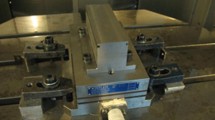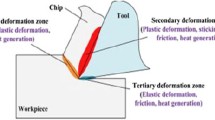Abstract
The adhesion wear of cemented carbide tool when machining GH907 was studied with white light interferometer, infrared imaging, and SEM-EDS. The adhesion wear morphology, wear mechanism and the wear rule of adhesion were analyzed, and the effect of different cutting time and different cutting speed on adhesive wear were analyzed. The conclusion will provide useful references for the optimization of cutting parameters and the improvement of the tool life.
Similar content being viewed by others
References
Davis J R. Tool Materials-ASM Specialty Handbook[M]. OH: ASM International, 1995
Stephenson D A, Agapiou J S. Metal Cutting Theory and Practice[M]. New York: Marcel Dekker; 1997
E O Ezugwu. Improvements in the Machining of Aero-Engine Alloys Using Self-propelled Rotary Tooling Technique[J]. Journal of Materials Processing Technology, 2007, 185(1–3): 60–71
F C Campbell. Superalloys[J]. Manufacturing Technology for Aerospace Structural Materials, 2006: 211–272
R L Kennedy, R M Forbes Jones, R M Davis, et al. Superalloys Made by Conventional Vacuum Melting and a Novel Spray Forming Process[J]. Vacuum, 1996, 47(6–8): 819–824
J S Wan, Z F Yue. A Low-cycle Fatigue Life Model of Nickel-based Single Crystal Superalloys under Multiaxial Stress State[J]. Materials Science and Engineering: A, 2005, 392(1–2): 145–149
J W Brooks. Forging of Superalloys[J]. Materials & Design, 2000, 21(4): 297–303
T Kitashima, H Harada. A New Phase-field Method for Simulating γ′ Precipitation in Multicomponent Nickel-base Superalloys[J]. Acta Materialia, 2009, 57(6): 2 020–2 028
T Link, S Zabler, A Epishin, et al. Synchrotron Tomography of Porosity in Single-crystal Nickel-base Superalloys[J]. Materials Science and Engineering: A, 2006, 425(1–2): 47–54
Florian Pyczak, Steffen Neumeier, Mathias Göken. Influence of Lattice Misfit on the Internal Stress and Strain States Before and After Creep Investigated in Nickel-base Superalloys Containing Rhenium and Ruthenium[J]. Materials Science and Engineering: A, 2006, 510–511: 295–300
E O Ezugwu, Z M Wang. Titanium Alloys and Their Machinability-a Review[J]. Journal of Materials Processing Technology, 1997, 68: 262–274
Domenico Umbrello. Finite Element Simulation of Conventional and High Speed Machining of Ti6Al4V Alloy[J]. Journal of Materials Processing Technology, 2008, 196: 79–87
Woei-Shyan Lee, Chi-Feng Lin. High-temperature Deformation Behaviour of Ti6Al4V Alloy Evaluated by High Strain-rate Compression Tests[J]. Journal of Materials Processing Technology, 2008, 75: 127–136
Y Q Wang, G Sayre. Synthesis of Simple and Platinum-modified Aluminide Coatings on Cobalt (Co)-base Superalloys Via a Vapor Phase Aluminizing Process[J]. Surface and Coatings Technology, 2008, 203(3–4): 256–263
A K Koul, F B Pickering. Serrated Yielding in Ni—Fe base Superalloys at 700 °C[J]. Scripta Metallurgica, 1982, 16(2): 119–124
S Miller. Advanced Materials Means Advanced Engines[J]. Interdisciplinary Science Review, 1996, 21(2): 117–129
Author information
Authors and Affiliations
Corresponding author
Additional information
Funded by the National Natural Science Foundation of China (No. 50705052)
Rights and permissions
About this article
Cite this article
Shao, F. Adhesion wear of carbide tool when machining GH 907. J. Wuhan Univ. Technol.-Mat. Sci. Edit. 25, 469–473 (2010). https://doi.org/10.1007/s11595-010-0025-8
Received:
Accepted:
Published:
Issue Date:
DOI: https://doi.org/10.1007/s11595-010-0025-8




